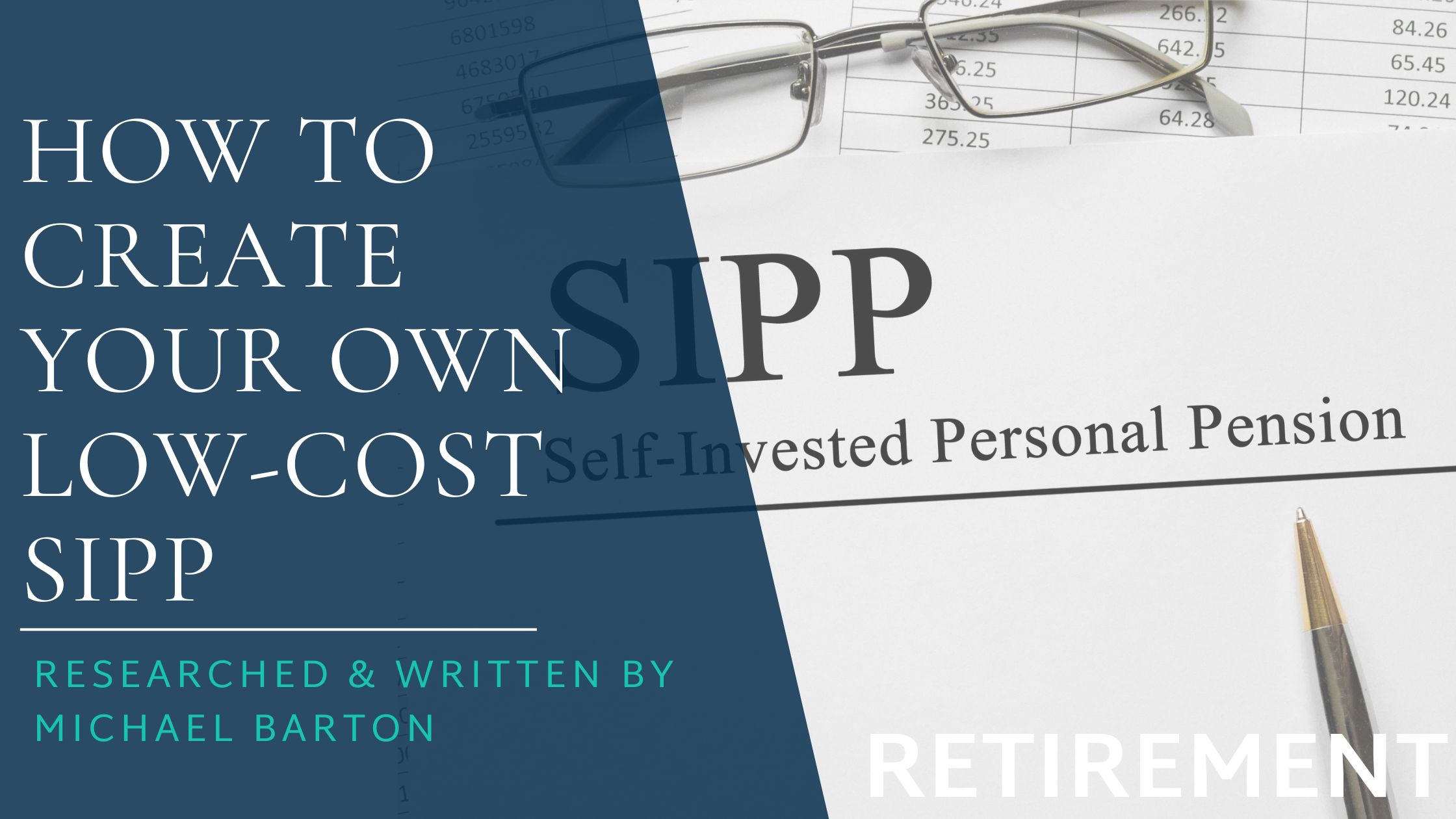If you want to take more control of your retirement planning, then a SIPP could be the solution. Here, financial expert Michael Barton talks you though how to create your own low-cost SIPP, as well as the pros and cons.
Wouldn’t it be great to be in control of your retirement planning? No relying on the State Pension or employers’ schemes to ensure your financial security in your older age? An investment vehicle that allows you to choose your own investments, instead of them being selected for you?
If you feel this way, then a Self-Invested Personal Pension (SIPP) could be the best choice for you.
In this article, I’m going to explain what a SIPP is, how it works, and how to set up a low-cost SIPP for yourself.
30-Second Summary
A Self-Invested Personal Pension (SIPP) puts the power of retirement planning in your hands. It’s an ideal vehicle for both employed and self-employed, and offers significant tax benefits.
You get to choose the investments bought, held, and sold within your SIPP, making it ideal if you have the time and inclination to take control of your investment. If you don’t, you can always invest in actively managed funds – it’s your choice.
A SIPP is also an ideal vehicle to consolidate existing pensions into a more easily managed structure (though you may need to seek advice on this), and the funds can be inherited, too.
Overall, opening a low-cost SIPP is a great strategy to complement your existing retirement arrangements (such as a workplace pension) and could enhance your retirement strategy.
The Basics: What is a SIPP?

A Self-Invested Pension Plan (SIPP) is a type of pension plan in which you make all the big choices. You can choose how much you contribute, and select the investments that you buy. If you want to invest in individual stocks or funds that offer you diversification, the choice is yours.
You can invest in a SIPP as well as paying into your workplace pension if you have access to one, and it doesn’t affect your entitlement to a State Pension when you reach retirement age.
This makes it a great solution if you are already contributing the maximum to your workplace pension and want to add more to your retirement pot. It’s also ideal if you’re self-employed and want a flexible pension option.
Of course, I need to give the standard warning here: the performance of your fund depends upon the performance of the investments you buy. Investments can go down as well as up.
However, if you’re not an experienced investor or don’t have the time to focus on investment choice, you can always invest in managed funds within a SIPP.
The Pros & Cons of a SIPP
Before you make up your mind whether to set up a SIPP, you should know what’s in it for you and understand the downsides, too.
| Pros | Cons |
|---|---|
| Tax relief on contributions | Performance is dependent on your investment choices |
| Easy to consolidate existing pension plans | Can be time-consuming if managing your own investments |
| Flexible contributions | You may need financial advice |
| Can contribute lump sums | Cannot access funds until age 55 (57 from 2028) |
| Can take a payment holiday | |
| SIPPs are inheritable, the fund doesn’t die with you | |
| 25% of fund available as tax free cash from age 55 (57 from 2028) | |
| Flexible options when taking income or proceeds from SIPP | |
| Control over investments in the SIPP | |
| SIPPs are usually cheaper, meaning more money is invested |
The Pros

First, investing in a SIPP is highly tax advantageous, just like other pensions. What you put in will benefit from tax relief. Usually, this means your contributions are topped up by 20% direct from HMRC.
This means that for every £80 you contribute as a basic rate taxpayer, you have £100 invested. If you pay tax at a higher rate, you can claim the tax relief at your marginal rate through your self-assessment form at the end of each tax year.
You can also combine existing plans into a single pension pot if you wish to do so (I did this, more about which a little later). This makes it easier to manage your pension pot. (You should always seek advice before doing this.)
You can also contribute varying amounts, making it easy to adjust contributions as your life evolves. For example, you can pay a lump sum into your SIPP if you are awarded a bonus at work, or inherit a sum of money. On the other hand, if you need a cash flow boost at any time, you can take a payment holiday.
When you die, any money remaining in your SIPP can usually be bequeathed to your heirs tax free, though there are certain rules around this. If you die before the age of 75, any withdrawals made by your heirs will normally be tax free. If you die aged 75 or older, any withdrawals may be tax liable.
You get access to your fund from the age of 55 (57 from 20028), and take 25% as a tax-free cash lump sum. Of course, you don’t need to take it at this time, and you have several options available to you, including:
- Take 25% tax free, and buy an annuity (to provide guaranteed income until you die)
- Take 25% tax free, and keep the rest invested to ‘drawdown’ when you need it
- Leave it all invested until you need a lump sum or income
As I said earlier, you’ll have far more flexibility in choosing the assets in which to invest.
You’ll also have a choice of a low-cost DIY SIPP, the ‘new’ breed of robo-advisor SIPPS, or a Full SIPP (which may be best for those with plenty of investment experience and time to commit to investment research – though you may also select to use the services of an investment team, for an extra charge).
The Cons
Control of your finances is a great thing, until something goes wrong! You will have no one to blame except the person in the mirror. You need to know what you’re doing, or take a good deal of advice.
Managing your investments in a Full SIPP can be time-consuming, though if you take advice or use managed funds this shouldn’t be a big consideration. A financial advisor/investment specialist can help you to select the best investments for your SIPP.
Like other personal pensions, you’ll pay tax on any lump sum you withdraw over 25% of the SIPP fund, and, though a SIPP is very flexible, you won’t be able to access your funds without a penalty/tax to pay before you reach 55 (57 from 2028).
Opening & Investing in a SIPP
The cheapest way to open a SIPP is to use an online SIPP platform. This allows you to control your investments from your smartphone, laptop, or other connected device. You’ll be able to see the value of your SIPP, alter contributions, and switch in and out of investments at the click of a mouse or swipe of your finger.
You can start a SIPP from scratch, or invest funds from existing pensions:
- A new contribution can be a lump sum, and you can also make monthly contributions.
- Transfers from existing pensions enable you to consolidate all those pensions into a single, more easily administered fund. You’ll need to take care if you are considering this, as you may have penalties to pay. You should also think long and hard before transferring any existing final salary/defined benefits plans into a SIPP.
On this second point, when I transferred my pensions, I found I had an existing final salary scheme that would pay me around £3,000 a year upon retirement. The transfer value on the fund was around £170k.
To me, a no-brainer to move! However, it’s not always so clear cut, and you should always seek advice; transfer values are not always so advantageous, and you are giving up guaranteed income for life.
5 Steps to Open a Low-Cost SIPP
There are five key steps you should follow to set up a low-cost SIPP:
1. Research & Choose a SIPP Provider
The first step is to select your SIPP platform. When doing this, you should:

Compare costs
The higher the costs of managing a SIPP on the platform, the more they will negatively impact your fund. Primarily, you’ll need to be mindful of platform charges, fees and commissions to buy and sell investment assets, as well as fund management and annual management charges.
You should also consider transfer-out fees (you may wish to move your funds to a different provider later) and income drawdown charges (fees levied to set up and withdraw money from the SIPP).
Check investment options
Does the platform allow you access to a range of investment choices that will help you achieve your financial goals? You’ll need to consider what assets you wish to invest in, and what funds the platform offers, too.
Remember, SIPP rules allow you to invest in a wide range of investments assets, including shares, managed funds, ETFs, and government and corporate bonds.
Compare reviews
You can learn a lot about different platforms from online reviews and feedback from existing customers.
2. Understand Your Investment Goals
The platform you choose must be able to cater to your investment goals. You’ll need to consider:
- Your risk profile – your attitude to risk and your tolerance of risk.
- Your investment timeline – consider how many years you have before your desired retirement age. This is a key factor in deciding a retirement investment strategy.
- Diversification – diversifying an investment portfolio reduces risk.
3. Open Your SIPP Account
The application process is relatively simple, and in most cases can be completed online. You’ll need to provide proof of identity, as well as some personal details and some financial information.
4. Fund Your SIPP
You will need to decide how to fund your SIPP, and you may need to pay an initial deposit.
If you are transferring existing pensions into your SIPP, you’ll need to complete the necessary forms to do so (and be wary of any charges or loss of benefits associated with those pensions).
(A tip here is to use a free pension-tracing service to locate any pensions that you may have lost track of – you may have a welcome surprise, like I did when I found a pension fund of more than £50k. You have nothing to lose from a free service like this, and plenty to gain.)
5. Choose Your Investments
Here’s the fun part!
Choose which investment assets are best suited to your investment profile, and then do your research to make individual investments within those asset classes. You might decide to select individual shares or bonds, invest in targeted ETFs, or invest via professionally managed, diverse funds.
Don’t forget, advice is always available from a financial advisor or investment specialist.
Who Can Open a SIPP?
To open a SIPP, you must be under 75 years old. You can also open a Junior SIPP for a dependent, or pay into another person’s SIPP (your spouse’s, for example).
Other than this, SIPP rules are the same as for other personal pensions.
Low-Cost SIPP Platforms
Here is a summary of a few of the lowest-cost platforms that offer SIPPs. I’ve split these into two types of platforms:
- DIY platforms, on which the choice of investments is left to you. Most offer shares, funds, and bonds. I haven’t included fund charges, as these vary according to the funds in which you invest within the SIPP.
- Robo-advice platforms, on which funds are selected for you based on your investment goals and risk profile. These are usually more expensive than DIY platforms, though you will often be investing in funds with low management charges.
| DIY Platforms | ||
| Platform | Costs | Investment Choice |
| AJ Bell | Free to set up, but fees include: Platform fee of up to 0.25% Buying fees of £1.50 (funds) and up to £9.95 (shares) Transfer-out fee of £9.95 | Invest in shares and a wide range of funds |
| Interactive Investor | Platform fee of £12.99 per month Buying fees of £5.99 per trade (though you do get one free trade per month) Transfer out fee £0 | Choose from more than 40,000 investments |
| Vanguard | Platform fee of 0.15% with a maximum of £375 per year Buying/selling fees £0 Transfer-out fee £0 | Only Vanguard funds, which mostly track the world’s stock markets |
| Robo-Advice Platforms | ||
| Moneyfarm | Account fee from 0.35% 0.75% of fund value each year Transfer-out fee £0 | Seven actively managed portfolios, invested in ETFs to suit different risk profiles |
| Nutmeg | Account fee of between 0.35% and 0.75% of fund value each year Transfer-out fee £0 | Range of funds from auto-rebalancing to fully managed |
| Penfold | Account fee from 0.40% 0.75% of fund value each year Transfer-out fee £0 | A range of actively managed plans designed for retirement investing |
| PensionBee | Account fee from 0.50% 0.95% of fund value each year Transfer-out fee £0 | A range of actively managed plans designed for retirement investing |
| Wealthify | Account fee of 0.6% Transfer-out fee £0 | Access to five portfolios based on your risk profile |
Should You Open a SIPP?
A SIPP can be a great way to help plan for your retirement. However, they aren’t the ideal solution for everyone. When deciding if a SIPP is right for you, consider the following questions:
Do you have access to a workplace scheme? If so, have you maximised your contributions into it?
Don’t forget that an employer is obliged to contribute to your workplace pension, and this is ‘free money’ going into your pension pot.
Do you have the experience or time to manage your own investments?
If the investments you make don’t perform as expected, you only have yourself to blame. This said, using a robo-advisor platform will largely remove your lack of experience or time from this equation.
Are you tech-savvy enough to manage your SIPP online?
Online platforms put the power in your hands, and are not too far removed from online banking. If you’re not confident with this technology, this may inhibit you from opening a low-cost SIPP online.
10 Tips to Get the Most from a Low-Cost SIPP
Planning for retirement is a crucial step in life planning. A key part of this is to use the best investment strategy. A SIPP could be a powerful piece of your pension armoury. Here are my tips to ensure it delivers on your expectations:
Start Early & Contribute Regularly
- The earlier you start, the more time your investments have to grow.
- Even small, regular contributions can build up significantly over time due to compound interest.

Take Advantage of Tax Relief
- Contributions to a SIPP are eligible for tax relief at your highest rate of income tax.
- Understand how much you can contribute while still receiving tax relief.
Keep Costs in Check
- Choose a low-cost SIPP provider with transparent fee structures.
- Monitor transaction and management fees, as these can eat into your returns over time.
Diversify Your Investments
- Spread your investments across different asset classes (e.g., stocks, bonds, funds) and sectors to reduce risk.
- Consider global investments to diversify across geographies.
Monitor Your Risk Profile
- As your life changes, so will your attitude to risk.
- Adjust your investments according to your risk profile, rebalancing your portfolio to maintain an appropriate asset allocation.
Plan for the Long Term
- SIPPs are a long-term investment. Avoid knee-jerk reactions to short-term market fluctuations.
- Adjust your investment strategy as you get closer to retirement, typically shifting towards more conservative investments.
Understand Withdrawal Rules & Regulations
- Familiarise yourself with the rules for accessing your SIPP funds, typically from age 55 (57 from 2028).
- Plan how you’ll withdraw funds in retirement to manage tax efficiency.
Consider Transferring Existing Pensions
- Consolidating your pensions can make it easier to manage your retirement savings.
- Check for any transfer fees or loss of benefits before moving your funds, especially final salary schemes.
Maximise Employer Contributions
- If you’re employed, check if your employer can contribute to your SIPP.
- Employer contributions can significantly boost your pension pot.
Plan for Estate Considerations
- Understand the implications of passing your pension to beneficiaries.
Remember, you’ll only maximise the benefits of opening a low-cost SIPP if you make informed investment decisions, monitor performance regularly, and adapt your strategy and investment choice to fit your evolving personal circumstances and retirement goals.
The Bottom Line
When you open a low-cost SIPP, you’ll benefit from a cheap, flexible, and tax-efficient way to manage your retirement planning. It provides a platform to tailor your retirement savings to your unique retirement goals.
However, while choosing your own investments allows you to benefit from higher potential rewards, you must remain cautious of the potentially higher investment risks you are taking.
The keys to maximising the potential benefits of a low-cost SIPP include understanding your investment goals, regularly reviewing your portfolio, and maintaining a diversified investment strategy.
Before opting for a low-cost SIPP, weigh up the pros and cons, and understand that a SIPP can be a valuable component of a comprehensive retirement plan, and a vehicle to grow your pension pot in a way that aligns with your personal financial goals and evolving life circumstances.

